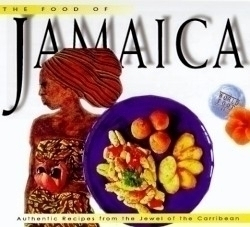Food of Jamaica
Authentic Recipes from the Jewel of the Caribbean (Foods of the World Series)
A travel guide with recipes might be the best way to explain The Food of Jamaica. The narrative helps explain how this island nation came to have the cuisine it does. The best explanation for Jamaica’s wide-ranging cuisine rests with the people who landed on its shores in the last few hundred years. The potpourri of immigrants - Spanish, the British, the Africans, even Irishmen and Germans - influenced the country’s cuisine.
The book wends its way through the country’s history, its people, cooking methods and topography. It’s refreshing to see this country through an epicure’s eyes rather than a cruise ship tourist’s. Here the rich traditions of tropical cooking are given their due. There are unexpected side trips to inform the reader about such things as the island’s rum and coffee trade. Why the island people came to learn to jerk meat is explained, as is the definition of jerk. The text would have been enhanced with more of the writer’s own observations.
The book begins with an overview of the country itself. The soil and climate are described, as are the different ethnic groups who inhabit the island, mainly immigrants who came to Jamaica much as they did to the United States in the 19th century. Work on the plantations proved to be the draw. Ninety-five percent of the people of the island trace their roots to Africa.
We learn Rastafarians eat only a vegetarian diet, mainly beans, peas and other fruits and vegetables. While they do smoke marijuana, they drink no alcohol. Several of the recipes in the book are vegetarian.
Finding the unusual ingredients listed in the recipes might deter the meek, but be assured that the author lists alternatives. For example, in the steamed acallaloo in phyllo dough recipe, the writer notes that spinach can be substituted for acallaloo. The ingredients themselves give a sense of the exotic: Pickapeppa sauce or stinking toe (a fruit whose powder is used in a custard). We learn tantalizing facts such as the tropical flowers and fruit on the island are transplants from countries such as Malaysia and India.
On a wish list for a future printing, it would be helpful to have photos of the dishes shown with the recipes. On the plus side, there are helpful sections on what utensils are used in the recipes and descriptions of the various island fruits and vegetables. (For example, sorrell is a flower, not a horse.)
Each recipe includes a time estimate in the form of small icons, and a short introduction that helps the reader get some sense of how Jamaicans regard it. Recipes, taken from Jamaican restaurants and chefs, are presented in a clear, matter-of-fact manner.
Reviewed by
Carol Hopkins
Disclosure: This article is not an endorsement, but a review. The publisher of this book provided free copies of the book to have their book reviewed by a professional reviewer. No fee was paid by the publisher for this review. Foreword Reviews only recommends books that we love. Foreword Magazine, Inc. is disclosing this in accordance with the Federal Trade Commission’s 16 CFR, Part 255.

